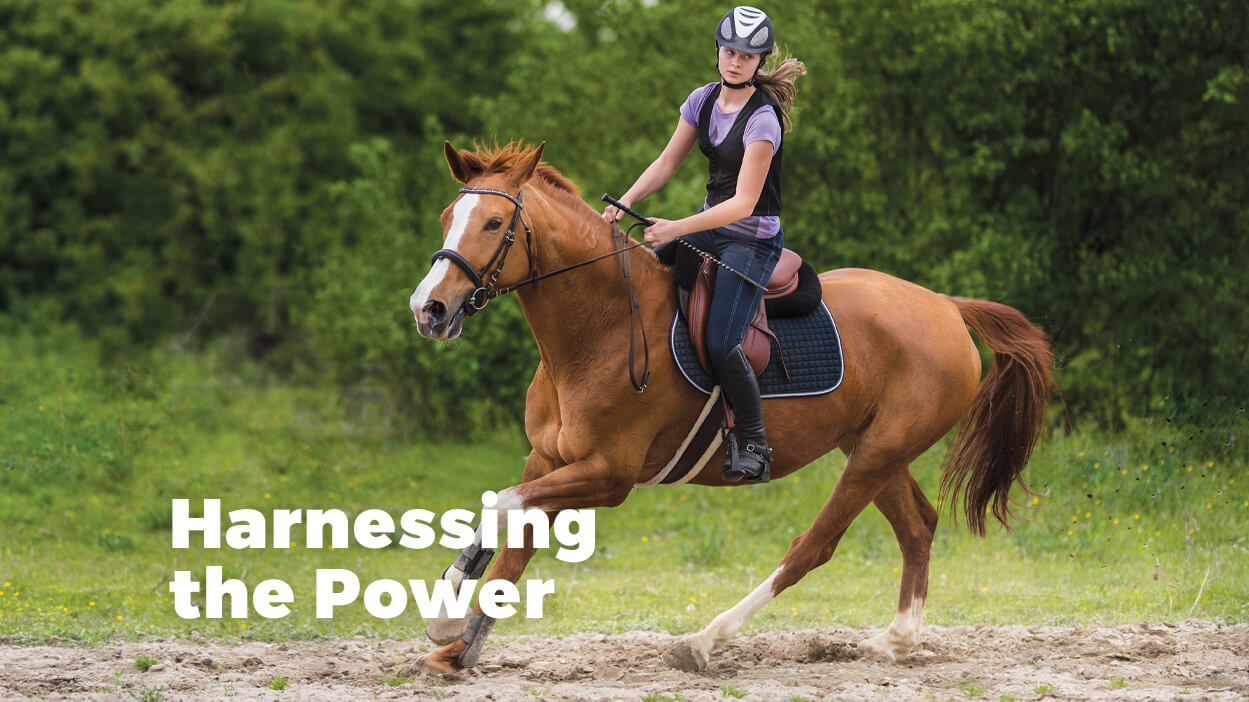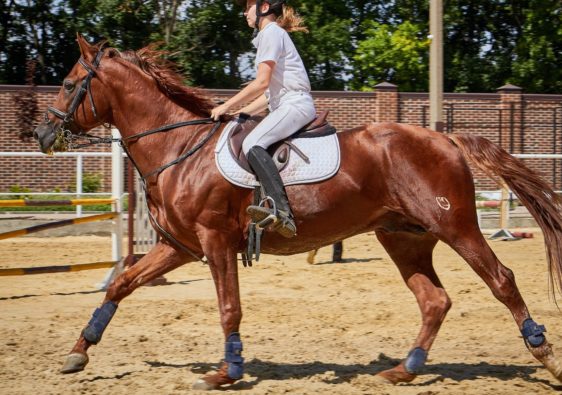Managing speed can often feel like a futile, sometimes intimidating struggle astride hot-blooded horses and those who seem to love getting everywhere quickly. When the horse gains speed, the natural reaction is to pull on the reins, and when that doesn’t work, intensify the bit. The reality, however, is that hauling on the reins tends to backslide into an unforgiving cycle of tug-of-war, a fight for control that can easily escalate.
Pulling on the bit – which constricts the jaw, head, and neck – triggers a chain reaction through the horse’s body that can hollow the spine, predisposing the horse to being stuck on the forehand and leaning on the bit, essentially trapping him in the very means of travel that leads the rider to pull in the first place.
Engaging seat and legs to guide your horse
Instead of blocking or aiming to control the horse with the reins, riding from the seat can influence the horse’s movement without creating an argument or causing pain to the delicate tissues in the horse’s mouth. In this way, rather than inhibiting the horse’s willingness to move, they’re allowed freedom of expression without a physical force essentially forcing their skeletal system out of alignment. Without the restraint against their mouths, the horse learns to not lean on the bit and can better develop the musculature for proper self-carriage. With consistent riding, the horse will learn to respond to seat and weight aids alone.
Contrary to instinct, the rider’s legs need to be engaged. The thigh adductors (groin muscles on the upper inside thigh) should be active without clenching to stabilize the rider while the hip abductors (the closing muscles of the hip where your front pockets are) are responsible for establishing and enforcing tempo. By “holding the rhythm with your pockets” with the lower leg present at the girth, you can both regulate the rhythm while still allowing freedom through the neck and enabling the horse to elevate the back. This develops their core muscles while constructively channeling their willingness to move.
Where pulling on the rein conflicts with their desire for forward movement, you are instead facilitating a positive transformation from speed into expression.
Putting it into practice
As soon as you pick up the trot, keep some tension in your “pockets” to maintain control of the posting rhythm. The sensation feels like activating resistance in front of your hip joints, deep in your pelvis. As soon as the horse’s tempo quickens, use a half-halt as the immediate correction instead of the rein, and the horse will learn to listen more closely to the seat without the resistance caused by an encumbered mouth.
Cueing the half-halt is essentially like asking for a downward transition, except with the lower leg engaged at the girth to keep the gait active and to engage the horse’s abdominals. Ask by weighting the seat bones towards your heels as you suspend the follow-through of your seat against the horse’s movement in the sitting phase, then resume following the movement with your seat and cue at the girth as you rise. A gentle squeeze and release on the rein at the start of the cue can be helpful when introducing the half-halt, but ultimately it is best to work towards not using the rein at all. Use resistance in your pelvis instead.
To regulate the horse’s reaction through the rising/release phase of the half-halt, repeat the retarding effect of the seat into the following strides, and wean down the degree of “halting” motion of the seat as the horse’s rhythm stabilizes.
By keeping the holding muscles in your pelvis engaged and setting the rhythm, it is easier to control the gait through the movements wherever the horse’s tendency is to accelerate.
Even in the canter, this same practice can be applied. Keeping your “pockets” activated maintains engagement with the seat through the canter effectively whether seated, in half-seat, or in two-point. That active tension or “holding” resistance actively maintains tempo and enables the rider to better respond immediately to sudden bursts from the horse.
Half-halting in the canter is essentially the same for the rider as in the trot, but timing may vary depending on the horse. Generally, applying the half-halt as the horse’s body rocks from the leading foreleg back onto the haunches tends to be most effective. The release phase can then follow immediately as the first hind leg bears weight, cueing with the lower leg at the girth for a deeper step with the inside hind. Resisting with your pelvis will help limit the stride length and tempo.
As in the trot, for best results, make the initial corrective half-halt the most firm, then in the strides that follow, lessen the intensity as the horse responds. With practice, it will become easier to gauge the degree of lower leg as well. Often it doesn’t take much, but as the horse learns to respond more to the seat aids, the lower leg cue will be especially helpful for improved activity.
Once this has been understood by the horse and practiced consistently on the flat, it can become an effective first response to sudden bursts even during a jumping course.
Proactively engaging with your “pockets” as you recover from a fence or come out of a line or corner will remind the horse to listen to your seat, checks their rhythm, and better enables them to rebalance and prepare for whatever comes next.
When the rider defaults to the rein, especially over fences, wrestling with the head can very easily throw the horse off balance or obstruct their own preparations for the next obstacle.
During schooling, if the horse is excitable, it’s always a good idea to tone it down and return to the basics. Practice transitions through walk and trot, and even walk and halt, holding the rhythm with your pelvic muscles and half-halting as necessary. This will get the horse listening to the seat again, reducing the likelihood of “arguments” while also letting their mind and body settle down.
Riding effectively from the seat is a far more effective means of communication that facilitates freer movement and happier rides for both rider and horse.
Find the article as originally published in Horse Sport:




